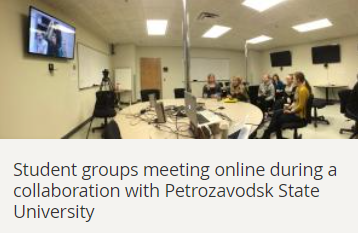New COIL cohort starting October 2, 2023 - Click on resources above for more details.
What is Collaborative Online International Learning?
Typically COIL projects involve the co-development of a course module by two or more instructors from different countries, each of whom recognize that a valuable kind of learning occurs when students from different parts of the world work together on a common area of focus.
The nature of the collaboration can take many forms. These projects can vary in length and format, from semester length projects to projects lasting only a few weeks, and from synchronous to asynchronous. Often instruction prepares students for collaborative group projects. Some COIL modules and courses involve face-to-face meetings before or after the course, but many do not.

Instead, COIL courses often embrace the use of digital technology to bridge the distance that separates countries and partners. Forms of interaction include online discussion groups, videoconferences, class to class meetings, and online workgroup projects. For a set of examples, see COIL Example courses (hosted by the Collaborative Online International Learning Center @SUNY) in the related links to the left. A list of ideas for COIL course models can be found under the Getting Started link above. In all COIL course projects, course goals remain focused on student-to-student interaction and the opportunity to learn together with those who have perspectives different from our own.
Can anyone develop a Collaborative Online International Learning project?

Advantages can be found in COIL projects in a wide variety of fields. When our students exchange perspectives with their international partners, the structural and cultural differences that inform our and our partners' assumptions force us to reexamine our own historical context, linguistic background, regional geography, economic environment, governmental framework and cultural heritage. When we use digital media to engage with partners abroad on a common area of interest, we often learn about new approaches to old problems by exploring in ways we had not anticipated. That means that COIL modules can be and have been developed in every major discipline.
Why pursue Collaborative Online International Learning?
COIL can take many forms, and each can augment and extend the impact of university study in a variety of ways. Before beginning a collaborative international learning project, and before discussing why collaboration is such an important facet of that work, it can be helpful to ask a few preliminary questions, such as the following: Have you ever been on a study abroad program as a student, or as an instructor, and have you ever seen the rich kind of learning that occurs when students engage in problem solving with students from another culture?

Why is that experience often characterized by expansive and thorough questioning of the frameworks that inform our decisions, practices and methods? Much like in study abroad, students in COIL courses engage with their peers in a rich and dynamic international context. Doing so has the potential to help students gather and process information of global relevance to their future career paths, while at the same time learning about how those career paths have taken on different shapes in different national contexts. Doing so promotes a robust form of curiosity and deepens our understanding of the differences and commonalities that color our world.
COIL holds promise for our campus, because there’s an inherent advantage to exchange between partners with different cultural assumptions, different historical and political trajectories, and different economic and linguistic backgrounds. International learning opportunities are critical to the internationalization of our campus, and for many students who are not able to travel abroad, online international team-based learning provides engagement with foreign cultures that achieves many of our internationalization goals.

By purposively harnessing the powerful learning potential of cultural differences and engaging with international partners in COIL course co-development, we also expand the breadth and depth of our international networks.

